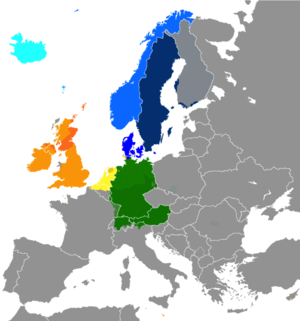West Germanic languages
group of languages
(Redirected from West Germanic language)
The West Germanic Languages are a branch of Germanic languages first spoken in Central Europe and the British Isles. The branch has three parts: the North Sea Germanic languages, the Weser-Rhine Germanic languages, and the Elbe Germanic languages. The most spoken languages in the branch are English, German, and Dutch.[1]
| West Germanic | |
|---|---|
| Geographic distribution: | Originally between the Rhine, Alps, Elbe, and North Sea; today worldwide |
| Linguistic classification: | Indo-European
|
| Subdivisions: | |
| ISO 639-5: | gmw |
 Extent of Germanic languages in present day Europe North Germanic languages West Germanic languages Dots indicate areas where multilingualism is common. | |
These languages were spread around the world in the Colonial Era. English is now spoken by around 400 million people natively.[2]
Branches
changeThere are three branches of West Germanic languages:
- North Sea Germanic / Ingvaeonic languages
- Anglo-Frisian languages
- Low German / Low Saxon
- Northern Low Saxon
- Schleswig dialects
- Holstein dialects
- Westphalian
- Eastphalia dialects
- Brandenburg dialects ("Märkisch")
- Pomeranian (moribund)
- Low Prussian (moribund)
- Dutch Low Saxon
- Weser-Rhine Germanic / Istvaeonic languages / Netherlandic / Low Frankish
- Elbe Germanic / Irminonic languages / High German
- German
- Alemannic, including Swiss German and Alsatian
- Swabian
- Austro-Bavarian
- East Franconian
- South Franconian
- Rhine Franconian, including the dialects of Hessen, Pennsylvania German, and most of those from Lorraine
- Ripuarian
- Thuringian
- Upper Saxon German
- Silesian (moribund)
- Lombardic AKA Langobardic (extinct, unless Cimbrian and Mocheno are in fact Langobardic remnants.)
- High Prussian (moribund)
- Luxembourgish
- Pennsylvania German language
- Yiddish (a language based on Eastern-Central dialects of late Middle High German/Early New High German)
- German
References
change- ↑ Hawkins, John A. (1987). "Germanic languages". In Bernard Comrie (ed.). The World's Major Languages. Oxford University Press. pp. 68–76. ISBN 0-19-520521-9.
- ↑ Crystal 2006, pp. 424–426.
Sources
change- Crystal, David (2006). "Chapter 9: English worldwide". In Denison, David; Hogg, Richard M. (eds.). A History of the English Language. Cambridge University Press. pp. 420–439. ISBN 978-0-511-16893-2.